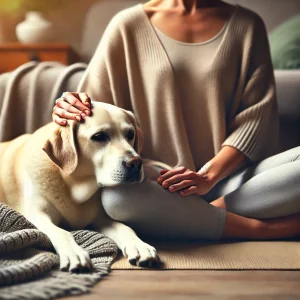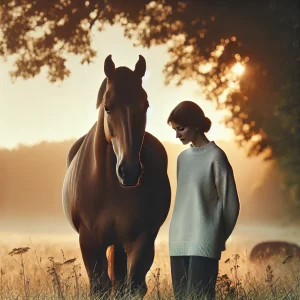Recognising the signs your dog is happy, isn’t just rewarding for us as pet owners — it’s essential to their well-being.
Dogs have their own unique ways of expressing joy, and being able to interpret these signals strengthens the bond we share.
But how can we tell if they’re truly content?
Happiness in dogs goes beyond tail wagging. For instance, when your dog’s ears are relaxed, and they’re wagging their tail loosely, it’s often a sign they feel safe and at ease.
So, what other cues reveal a happy dog?
Understanding these signals helps us not only ensure their comfort but also notice any signs of distress early on. After all, a happy dog is a healthier dog.
Let’s explore some of the most common indicators of a content canine, with practical examples you might notice in everyday life.
8 Signs Your Dog Is Happy
Understanding the signs your dog is happy can help you ensure that your furry friend is living a joyful, fulfilled life.
While every dog is unique, there are common behaviours that typically indicate contentment and well-being.
Discover these easy-to-use, tried and tested methods that open a new perspective on understanding an animal’s emotions – check our Animal Communication Course.
From the way they wag their tail to how they sleep, these signals can offer insight into their emotional state.
Here are eight key signs that can help you recognize when your dog is truly happy.
1. Tail Wagging
A wagging tail is one of the most recognizable indicators of a happy dog. Yet, the way a dog wags can reveal different emotions.
For instance, a relaxed, loose wagging motion often signals happiness, while a stiff, high tail position might indicate alertness or even tension.
Dogs wagging with a low, slow motion could be unsure or anxious. Paying attention to tail position alongside the wagging style can help clarify how they’re truly feeling.
2. Playfulness
Happy dogs are typically eager to engage in playful activities, and they show it through various playful behaviours.
For instance, if your dog does a “play bow” by lowering its front legs and raising its hindquarters, it’s an invitation for some fun!
Another common gesture is when they bring you a favourite toy, nudging it toward you to join in the play. This playful energy is often a reliable sign of a happy and content dog.
3. Relaxed Body Language
A content dog usually has a relaxed, open posture that’s easy to recognize. Signs include a loose body, floppy ears, and a gentle facial expression.
In contrast, when dogs are stressed, they often display tense muscles, pinned-back ears, or lowered body posture. Recognizing this contrast can help you determine when your dog is truly at ease versus when they’re feeling anxious or uncomfortable.
4. Healthy Appetite
A happy dog generally has a healthy, consistent appetite, showing enthusiasm for regular meals. Of course, there may be exceptions—such as temporary changes due to health issues or age—but an ongoing interest in food is a positive sign.
If you notice a significant change in their eating habits, it may be worth exploring further, as it could indicate a shift in mood or health.
5. Frequent Barking or Vocalization
Vocal dogs often use barking, whining, or other sounds to express excitement or happiness.
This can be especially true during playtime or when they see someone they love. However, it’s important to differentiate between happy vocalizations and those that signal stress.
For example, high-pitched yips may convey excitement, while prolonged, low whining could indicate discomfort.
6. Seeking Affection
A happy dog tends to seek out physical affection, nudging for petting or curling up close. Some dogs may gently paw at you, rest their head on your lap, or press against you to get closer.
These behaviors show that they feel secure and trust you, which is a key element of a happy, fulfilling relationship between you and your dog.
7. Good Sleep Patterns
Dogs who feel safe and content usually have regular, restful sleep. They may nap with their bodies relaxed, stretched out, or curled in a comfortable position.
Signs of stress, such as restlessness or disrupted sleep, can suggest they’re not feeling as content as they could be. Observing their sleep habits can reveal a lot about their overall happiness and comfort in their environment.
8. Exploration and Curiosity
Happy dogs show a natural curiosity about their environment, sniffing around and exploring new areas. This interest in their surroundings is a sign of confidence and engagement.
Whether it’s sniffing the grass on a walk, investigating a new toy, or simply observing activities at home, these behaviours suggest a dog who’s not only comfortable but excited about life’s little discoveries.
How to Make Your Dog Happier
Ensuring a dog’s happiness goes beyond fulfilling basic needs; it’s about nurturing their emotional and physical well-being.


Here are some practical ways to increase your dog’s happiness:
1. Regular Exercise and Playtime
Consistent exercise is essential for a dog’s physical health and can greatly impact their happiness. Whether it’s a daily walk, a run in the park, or a game of fetch, physical activity releases pent-up energy and reduces boredom.
Active dogs are generally less prone to behavioural issues, as they have an outlet for their energy and a chance to explore. Plus, regular play strengthens your bond, reinforcing trust and affection.
2. Mental Stimulation Through Toys or Training
Mental exercise is as important as physical exercise for dogs. Engaging toys, puzzle feeders, or training sessions encourage problem-solving and keep your dog’s mind active.
For example, teaching them new tricks not only challenges them mentally but also builds confidence.
Mental stimulation reduces boredom and prevents behaviors associated with frustration, like excessive barking or chewing, contributing to a happier, well-adjusted dog.
3. Quality Time Spent Together
Dogs are social animals that thrive on companionship, and spending quality time with them reinforces a sense of security. Simply sitting with them, giving them affection, or playing games together builds a bond that enhances their emotional well-being.
Interestingly, dogs can even pick up on human emotions, so positive, loving interactions reassure them that they’re safe and valued. This connection can be particularly comforting in new or stressful situations, helping them feel calm and secure.
4. Providing a Comfortable and Safe Environment
A stable, secure home environment is crucial for a dog’s happiness. Make sure they have a designated space where they feel safe and comfortable, complete with a cosy bed and some favourite toys.
This sense of stability and safety reduces anxiety, especially for dogs that may feel nervous in unfamiliar surroundings. In a familiar, comfortable space, your dog can fully relax, knowing they’re in a safe place.
5. Regular Veterinary Check-ups to Monitor Health
Routine vet visits are a proactive way to ensure your dog stays healthy and comfortable, and in turn, happier. Regular check-ups can help catch health issues early, preventing discomfort or pain that can affect their mood and energy levels.
Staying on top of vaccinations, dental care, and overall health contributes to a longer, healthier, and more joyful life, free from the stress of unnoticed health concerns.
Conclusion
In the end, a dog’s happiness is often reflected in the little moments we share with them. By recognizing signs of joy—whether it’s through a playful tail wag or relaxed body language—and taking steps to enrich their life, we can ensure our furry friends feel safe, loved, and understood.
Happiness is a combination of mental, emotional, and physical well-being, and as their caregivers, we have the unique opportunity to nurture each of these aspects.
From regular exercise to quality time and routine vet care, every effort we make enhances their quality of life, ensuring a bond filled with trust and joy. After all, a happy dog makes for a happy home.
But if you really want to understand your dogs’ well-being on a deeper level. Then learning animal communication will give you the skills to understand how they feel physically and emotionally. It is a great addition to enhancing the observations that can be made. Animal Communication Course.











Responses